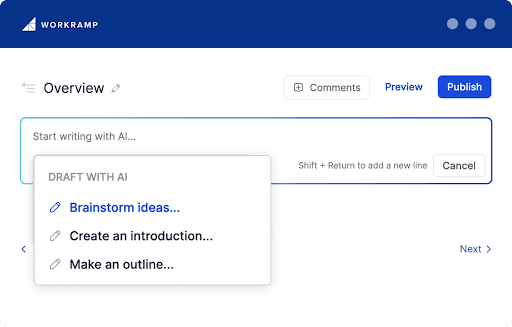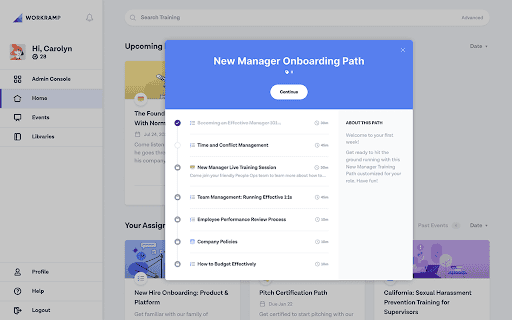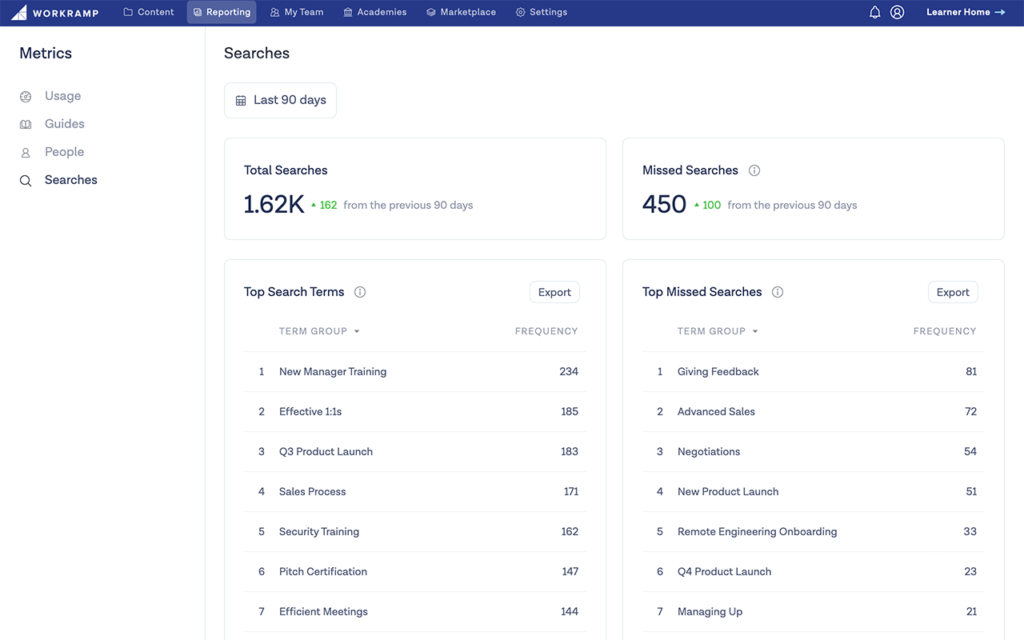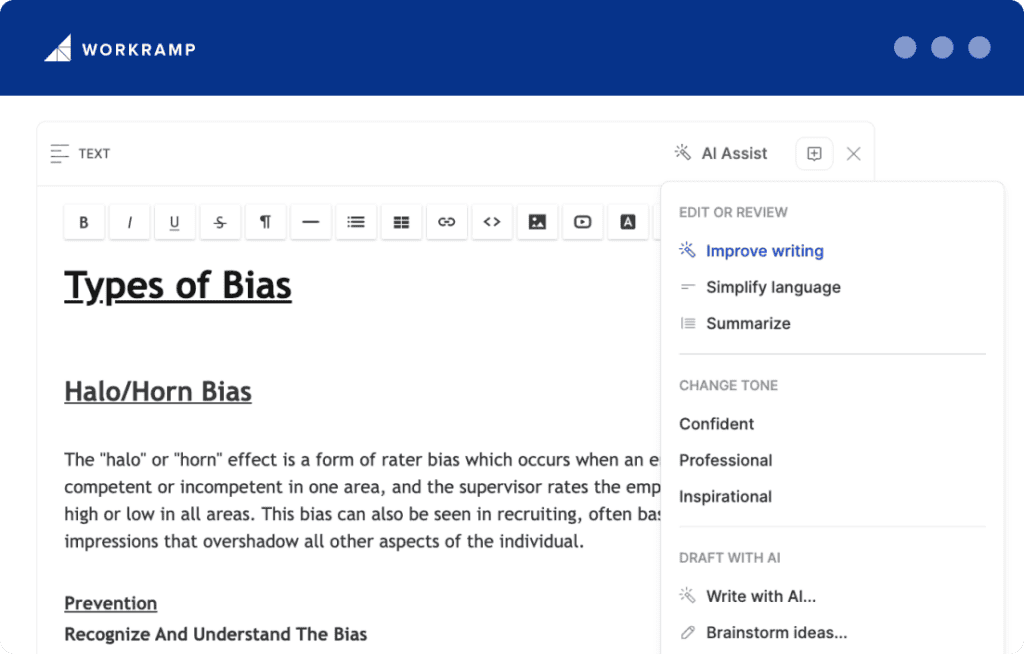How AI Is Used in Learning & Development in 2024
Elise Dopson | WorkRamp Contributor
View bioLearning Tips Straight to Your Inbox
As an L&D manager, your resources are finite. You don’t always have hours to spend researching your students and crafting courses, nor obsessing over numbers to calculate the effectiveness of your programs.
Artificial intelligence, however, can complete those jobs in a matter of seconds. The technology uses machine learning to spot patterns, make decisions, or learn from the data they’re given. It’s no wonder why 93 percent of service professionals with AI say the technology saves them time, and 77 percent say it’s already improving their productivity.
AI has the power to transform your L&D programs so that they’re not only more efficient to manage but also more enjoyable for your learners to interact with. This guide shares how to do it, complete with practical use cases for AI in learning.
In this post:
Why is artificial intelligence (AI) important in learning and development?
Here’s how that plays out in the three top priorities for L&D.
AI in education
AI is a useful tool when you’re educating students virtually. You can personalize learning experiences to individual needs and preferences, automate administrative tasks, and produce new content. This allows you to allocate more time and resources to strategic planning and personalized learner support.
AI in employee training
Employee training programs cater to the 55 percent of employees who feel they need additional training to perform better in their roles. When you use AI to produce training content and analyze learning data, you’re able to deliver more personalized, efficient, and effective experiences at scale.
For example, an AI-powered learning platform could recommend specific courses, modules, or resources based on employees’ job roles, learning styles, and skill gaps. Or if an employee demonstrates that they’re retaining the knowledge you’re teaching and breezing through a specific module, the AI LMS could automatically advance them to more challenging material to keep them engaged.
- “It would be great for AI to dynamically adjust content offerings based on somebody’s progress or performance. Instead of testing out of a certain course, I could see AI pushing learners down their respective paths if they need remedial training or if they’re ready to advance to the next thing.” —Ariana Jarvis, Manager of Enablement Operations at Avalara
AI in customer learning
A customer education program brings new customers up to speed with your products and services. Not only is it a competitive advantage to provide this personalized support at scale, but it can help them get the most value out of their purchase. This can go a long way in reducing customer churn.
Chatbots are perhaps the most common use case of AI in this context. A study by Tidio found that 88 percent of people have already interacted with a brand’s chatbot, and 62 percent are happy to discuss something with a chatbot over a real person.
AI-powered chatbots can serve as virtual assistants to guide customers through training materials, answer questions, and provide support in real-time. There’s no need to wait around for a person to answer it—customers get an instant response to their questions.
What Are the AI Tools You Can Use for Customer Education?
AI’s role in learning and development
Now we know the part AI has to play in L&D programs, let’s explore seven use cases of how you might use it in your own strategy.
Generative AI for content creation

Generative AI is a type of AI with the ability to produce new content, such as text, images, or even multimedia content.
Input your prompt into a generative AI tool like AI Assist, referencing key details like learning objectives, target audience, and preferred style. The tool generates content on your behalf in a fraction of the time it’d take to produce the learning content manually, while also diversifying learning materials to cater to different learning styles.
“Generative AI is here to stay, and like many have said, it’s not about generative AI taking a marketer’s job–I don’t see that happening,” says Sara Patel, head of customer education at Jasper. “But a marketer who uses generative AI proficiently will definitely have an edge over someone who doesn’t use it at all or doesn’t use it well.”
AI video generation
Video is a powerful tool you can use to deliver knowledge and upskill your team. A Wyzowl report found that 91 percent of people have watched an explainer video to learn more about a product or service.
Advancements in AI means you no longer need to refine your own video production skills or hire expensive agencies to produce video content for your eLearning programs. Generative AI tools like Synthesia and Runway will make a customized video based on your prompt. Three-quarters of video are already tapping into these AI tools to create or edit videos, according to the Wyzowl report.
Take it from Algolia, a SaaS company that enlisted the help of WorkRamp to produce video-led training content. “In the past, many of our onboarding sessions would happen as live, interactive lessons—in the era of remote work, we’re learning how we can recreate those learning moments with videos and virtual events,” says Lish Gates, the company’s global revenue enablement leader.
Lish continues: “WorkRamp’s newly revamped events feature has made it easier than ever to plan virtual onboarding bootcamp sessions.” The results speak for themselves: Algolia trained 109 external partners in six months, and 89 percent of students completed its customer education courses.
AI chatbots or virtual assistants
How many hours do you spend each week responding to your learners? Whether you’re providing feedback on their end-of-module quiz or helping them to locate specific training materials, AI can shave that time down so you can spend more time on higher-impact activities.
For example, chatbots and virtual assistants can provide new employees with information about company policies, procedures, and resources, guiding them through the onboarding process. They can also offer personalized recommendations for courses, resources, and learning pathways based on individual learners’ needs, preferences, and performance data.
Customizing learner paths

L&D programs shouldn’t take a one-size-fits-all approach. Even if employees are in the same role or customers fit the same persona, previous skills, experiences, and interests should guide the training materials you’re recommending.
Take it from Sara Patel, head of customer education at Jasper, who leaned on WorkRamp’s AI features to forge personalized paths for its learners. She says: “Because we are committed to our customers, we’ve invested the time early on to determine what metrics are needed for our customers to be successful using Jasper within their organization, provided a training path to help them get there, and a certification so they can show their network and future employers what they’ve accomplished.”
“Industry leaders stay industry leaders because they give their customers the tools and support to use their product successfully,” Sara adds.
Adaptive tests, assessments, and automated grading
Delivering your learning content is one part of the puzzle. Instead of assuming that learners have retained the information you’ve taught, use adaptive tests, assessments, and grading inside your AI LMS to check that this is happening.
WorkRamp, for example, allows you to create interactive quizzes, challenges, and simulations that reward customers with badges, points, or virtual prizes for completing training tasks. This encourages learner participation and helps with knowledge retention since learners have to retrieve the information they’ve just absorbed.
You can even use AI to identify skills gaps before creating your eLearning content. Run a pre-assessment to identify learners’ existing knowledge and skill levels, then plug the gaps in your content.
Advanced data analysis

Are your learning and development initiatives meeting their intended objectives? Your answer shouldn’t be based on a gut feeling. Concrete data, which AI can help you source, is evidence to support your program. This helps you get buy-in from stakeholders to increase L&D budgets while also increasing learner satisfaction.
For example, you could use predictive analytics to determine which training methods or content formats are most likely to positively impact student grades. AI can even help you to pinpoint learners that are most at risk of falling behind based on their assessment data, giving you a priority list of students to reach out to with personalized support.
Taking, analyzing, and using meeting notes
Not all eLearning programs are asynchronous. Sometimes there’s a need for synchronous communication; training sessions that take place at a certain place, at a certain time—such as virtual instructor-led training sessions through Zoom.
Automated meeting note-takers eliminate the need for manual note-taking. The software can join your virtual meeting room and describe your conversations, which makes for easy referencing later. Tools like Otter can even organize and categorize your notes in a central repository. This promotes knowledge sharing and fosters a stronger learning environment.
How to integrate AI into your learning and development programs
If you’re ready to integrate AI tools into your learning environment, follow this three-step approach.
Choose the right AI LMS

An AI-powered LMS is the vehicle that you’ll use to deliver your learning content. But not all LMSes are created equal. Some don’t have the advanced AI tools you’ll need to create content and personalize the learning experience. The last thing you need is monthly subscriptions for different AI tools for each use case.
WorkRamp’s AI-powered LMS, for example, has its own generative AI capabilities to produce top-notch content at scale. You can use it to:
- Write new content and brainstorm training ideas based on an AI prompt
- Improve the writing of your eLearning content
- Simplify the language to make training materials easier to understand
- Make your content more digestible by summarizing copy into key takeaways
- Change the tone of your existing copy to make it more confident, professional, or inspirational
Understand AI limitations
Despite the rapid adoption of artificial intelligence and the software that powers it, the reality is: it’s still learning. AI isn’t yet a perfect end-to-end solution for your L&D programs. The main limitations to be aware of include:
- Bias. AI algorithms can perpetuate biases that are present in whatever data the tool has been trained on. Before implementing AI in your own L&D programs, check that its training model promotes diversity, equity, and inclusion—and always do a final run-through of any content you’ve created to check for bias.
- Data privacy. AI relies on large amounts of data. When using AI in your own program, you must ensure that learner data is handled responsibly, protected from unauthorized access, and used only for legitimate purposes.
- Costs. AI technology can be expensive and resource-intensive, particularly for smaller teams or those with limited L&D budgets.
“AI-generated content is helpful, but requires human oversight, and not just for accuracy,” says Casey Keenan, Senior Manager of Training and Development at The Farmer’s Dog. “AI tools don’t understand bias and gender representation. As an L&D leader, you need to guarantee your programs are inclusive to everyone and create a safe space where people can see themselves in your content and connect with it.”
Include a human touch
AI-driven learning experiences may lack the human touch and personalized interaction that some learners prefer. This is especially true in situations where empathy, emotional support, or mentorship are essential.
If you’re hosting a customer service training program, for example, you might be teaching students the importance of empathy when dealing with unhappy customers. Role-playing is the ideal medium to teach this concept—which is something you can’t always rely on AI for.
Optimize your AI learning program with WorkRamp
The tools you’re using to operate your L&D program play a major role in not just how easy it is to produce training materials, but also the satisfaction of your learners. After all, there isn’t much use in spending hours creating new L&D programs if they don’t meet their learning objectives.
WorkRamp condenses popular generative AI features into a single LMS without the need for multiple third-party apps. You can produce new content, change the tone of your materials, and brainstorm new ideas—all from the same LMS that powers your employee, customer, and partner training programs.
With AI Assist, it’s never been more accessible to use AI to run an efficient eLearning program. Contact our team today to see the AI LMS in practice.
Complete the form for a custom demo.
Recent Posts
- WorkRamp Launches AI Practice to Revolutionize Sales Enablement July 22, 2024
- How to Recognize Employee Burnout July 17, 2024
- What is the Best SCORM-compliant LMS? July 10, 2024
- How to Make a Training Module For Online Learning (2024 Guide) July 1, 2024
- The Role of Emotional Intelligence in Sales Enablement June 28, 2024
Elise Dopson
WorkRamp ContributorElise Dopson is a freelance writer for B2B SaaS companies. She’s also the co-founder of Peak Freelance and mom to an adorable Spaniel pup.
You might also like
WorkRamp announces the launch of AI Practice to scale and uplevel sales pitch enablement
Today we’re excited to announce the launch of our latest AI functionality in the WorkRamp platform, AI Practice, designed to scale and modernize the way you deliver sales pitch enablement. Powered by Hyperbound, AI Practice provides sales reps with an interactive, customizable practice environment that helps them refine their pitches, gain call confidence, and close […]
Read More
How to Recognize Employee Burnout
By helping your team members manage stress more effectively, you can mitigate and prevent employee burnout, leading to higher job satisfaction, better performance, increased engagement, and decreased turnover.
Read More
What is the Best SCORM-Compliant LMS?
Discover features & benefits of the best SCORM-compliant LMS platforms. Learn what SCORM compliance means & how it works in learning management systems.
Read More
How to Make a Training Module For Online Learning (2024 Guide)
Master online course creation with our 2024 guide to crafting engaging training modules for sales, revenue enablement, customer training, and more.
Read More
The Role of Emotional Intelligence in Sales Enablement
Emotional intelligence (EQ) is the ability to understand and regulate emotions. Learn how sales teams boost relationships and sales by mastering emotional intelligence.
Read More
Learn more about our partnership with Udemy Business
We're thrilled to offer the award-winning NINJIO AWARE training content, to engage learners, produce real results, and protect your company.
Read More


